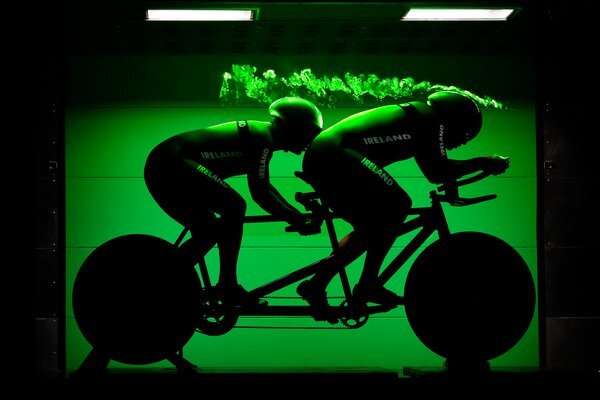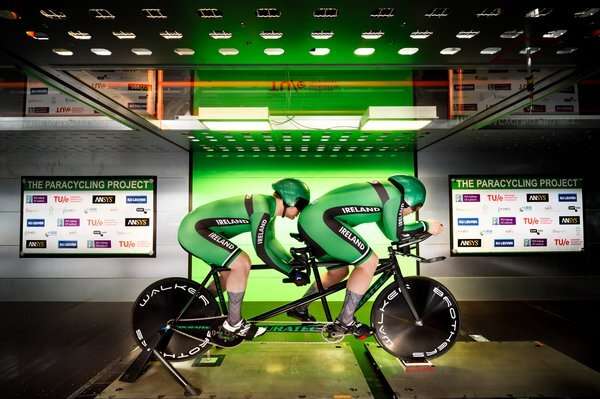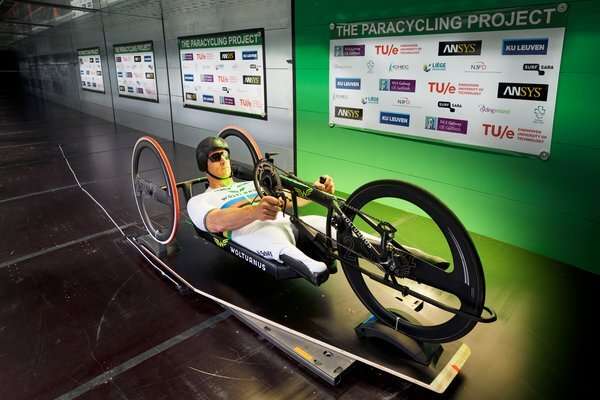New aerodynamic insights could change the para-cycling podiums

Participants in Para-cycling races – cycling with a disability – would do well to study Paul Mannion's Ph.D. research. At Eindhoven University of Technology and National University of Ireland Galway he has been investigating the aerodynamic resistance of tandem and hand cyclists. The optimal posture appears to give tandem cyclists an advantage of 8.1 seconds per 10 kilometers, while the correct choice of wheels can give hand cyclists a gain of 1.6 seconds per kilometer. This could make the difference between winning or losing.
The research project was led by National University of Ireland Galway and Eindhoven University of Technology (TU/e) in collaboration with KU Leuven in Belgium and software company ANSYS. The experimental work was conducted in the wind tunnels of TU/e and the University of Liège and was led by Civil Engineers Professor Bert Blocken of TU/e and KU Leuven and Dr. Eoghan Clifford of NUI Galway. Clifford is a 4-time world champion and current para-cycling Champion and initiated the research with Blocken. Blocken: "Para-cycling aerodynamics has never before been extensively and scientifically investigated using wind tunnel tests and computer simulations. Because the riders can reach speeds of up to 54 kilometer per hour and more, air resistance is a key performance factor. So there is a lot to be gained by aerodynamic research."
Up to 8.1 second advantage for tandem cyclists
Some of the results were unexpected, especially those for tandem cycling. Here, a sighted rider – the pilot – sits at the front, while the rear rider—the stoker—has a visual impairment. "You would expect athletes to experience the least resistance in a race when bending over the bike as much as possible. But our research shows that the aerodynamics are better if the pilot adopts a more upright position. This helps to shield the stoker from the wind, reducing the total resistance of the two riders," explains Paul Mannion.

Of the 23 combinations of race postures that were researched, the optimal torso angle – the angle between the horizontal rod and the torso from tailbone to head – turned out to be 25 degrees for the pilot and 20 degrees for the stoker. Blocken: "This results in a 6.5 seconds faster time over a distance of 10 kilometer, compared to the posture where both athletes bend as low as possible over the handlebar."
There is even more to gain in time-trials. Most tandem cyclists adopt the so-called time-trial position, while the researchers show that the frame-clench posture, in which the stoker grasps the pilot's seat post, is faster. "Compared to this standard position, there is a time gain of no less than 8.1 seconds over a distance of ten kilometer," explains Blocken.

A 1.6 second gain per kilometer for hand cyclists
The researchers also tested hand cyclists, using both wind tunnels and computer simulations. Here, the wheel type had a very large impact on aerodynamic resistance, especially in crosswinds. Para-handcycles have three wheels; one at the front and two at the back of the cycle. Mannion: "Cyclists tend to choose three disk wheels, but we have shown that this increases the overall resistance. A disk wheel at the front and two spoked wheels at the back of the cycle result in much lower resistance. This effect is most evident in crosswinds, but also holds for winds from other angles. Blocken: "With 10 degrees of crosswind, an advantage of up to 1.6 seconds can be achieved over 1000 meter."
Even larger aerodynamic gains are possible during hill descents, when handcyclists don't pedal and reach speeds of up to 60 kilometers per hour. Here, the position of the arms turned out to be the deciding factor. Mannion saw that most riders pressed their arms against their body during the descent – the so-called 6 o'clock position – assuming that this would reduce aerodynamic resistance the most. But the wind tunnel and computer simulations showed otherwise: a position with the arms extended – the 9 o'clock position – proved to be much more effective. Mannion: "This optimal posture leads to 4.3 percent less drag compared to the 6 o'clock position."
Provided by Eindhoven University of Technology





















